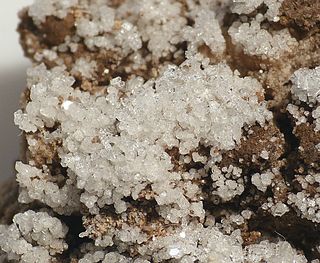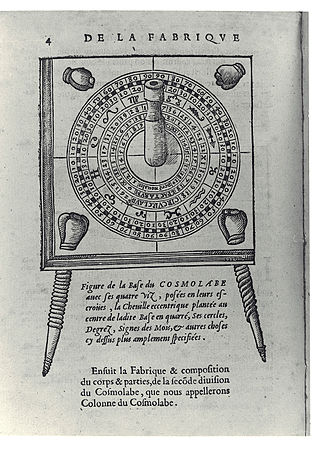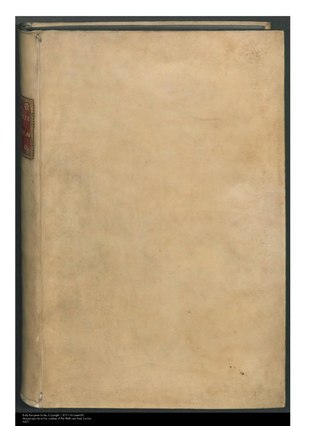
Georgius Agricola was a German Humanist scholar, mineralogist and metallurgist. Born in the small town of Glauchau, in the Electorate of Saxony of the Holy Roman Empire, he was broadly educated, but took a particular interest in the mining and refining of metals. He was the first to drop the Arabic definite article al-, exclusively writing chymia and chymista in describing activity that we today would characterize as chemical or alchemical, giving chemistry its modern name. For his groundbreaking work De Natura Fossilium published in 1546, he is generally referred to as the Father of mineralogy and the founder of geology as a scientific discipline.
Major innovations in materials technology

Salammoniac, also sal ammoniac or salmiac, is a rare naturally occurring mineral composed of ammonium chloride, NH4Cl. It forms colorless, white, or yellow-brown crystals in the isometric-hexoctahedral class. It has very poor cleavage and is brittle to conchoidal fracture. It is quite soft, with a Mohs hardness of 1.5 to 2, and it has a low specific gravity of 1.5. It is water-soluble. Salammoniac is also the archaic name for the chemical compound ammonium chloride.

Cyril Stanley Smith was a British metallurgist and historian of science. He is most famous for his work on the Manhattan Project where he was responsible for the production of fissionable metals. A graduate of the University of Birmingham and Massachusetts Institute of Technology (MIT), Smith worked for many years as a research metallurgist at the American Brass Company. During World War II he worked in the Chemical-Metallurgical Division of the Los Alamos Laboratory, where he purified, cast and shaped uranium-235 and plutonium, a metal hitherto available only in microgram amounts, and whose properties were largely unknown. After the war he served on the Atomic Energy Commission's influential General Advisory Committee, and the President's Science Advisory Committee.

Mercury silvering or fire gilding is a silvering technique for applying a thin layer of precious metal such as silver or gold to a base metal object. The process was invented during the Middle Ages and is documented in Vannoccio Biringuccio's 1540 book De la pirotechnia. An amalgam of mercury and the precious metal is prepared and applied to the object which is then heated, sometimes in oil, vaporizing most of the mercury. The technique is dangerous since mercury is highly toxic, especially in its vapor phase. Mercury silvering can be detected through a variety of methods.

Vannoccio Biringuccio, sometimes spelled Vannocio Biringuccio, was an Italian metallurgist. He is best known for his manual on metalworking, De la pirotechnia, published posthumously in 1540.

Cupellation is a refining process in metallurgy in which ores or alloyed metals are treated under very high temperatures and subjected to controlled operations to separate noble metals, like gold and silver, from base metals, like lead, copper, zinc, arsenic, antimony, or bismuth, present in the ore. The process is based on the principle that precious metals typically oxidise or react chemically at much higher temperatures than base metals. When they are heated at high temperatures, the precious metals remain apart, and the others react, forming slags or other compounds.

Hieronymus Froben (1501–1563) was a famous pioneering printer in Basel and the eldest son of Johann Froben. He was educated at the University of Basel and traveled widely in Europe.

De re metallica is a book in Latin cataloguing the state of the art of mining, refining, and smelting metals, published a year posthumously in 1556 due to a delay in preparing woodcuts for the text. The author was Georg Bauer, whose pen name was the Latinized Georgius Agricola. The book remained the authoritative text on mining for 180 years after its publication. It was also an important chemistry text for the period and is significant in the history of chemistry.
Richard Eden was an English alchemist and translator. His translations of the geographical works of other writers helped to foster enthusiasm for overseas exploration in Tudor England.

Jacques Besson (1540?–1573) was a French Protestant inventor, mathematician, and philosopher, chiefly remembered for his popular treatise on machines Theatrum Instrumentorum (1571–1572), which saw many reprints in different languages.
Liquation is a metallurgical method for separating metals from an ore or alloy. The material must be heated until one of the metals starts to melt and drain away from the other and can be collected. This method was largely used to remove lead containing silver from copper, but it can also be used to remove antimony from ore minerals, and refine tin.

De Natura Fossilium is a scientific text written by Georg Bauer also known as Georgius Agricola, first published in 1546. The book represents the first scientific attempt to categorize minerals, rocks and sediments since the publication of Pliny's Natural History. This text along with Agricola's other works including De Re Metallica compose the earliest comprehensive "scientific" approach to mineralogy, mining, and geological science.
Early writing on mineralogy, especially on gemstones, comes from ancient Babylonia, the ancient Greco-Roman world, ancient and medieval China, and Sanskrit texts from ancient India. Books on the subject included the Naturalis Historia of Pliny the Elder which not only described many different minerals but also explained many of their properties. The German Renaissance specialist Georgius Agricola wrote works such as De re metallica and De Natura Fossilium which began the scientific approach to the subject. Systematic scientific studies of minerals and rocks developed in post-Renaissance Europe. The modern study of mineralogy was founded on the principles of crystallography and microscopic study of rock sections with the invention of the microscope in the 17th century.
The year 1530 in science and technology included many events, some of which are listed here.
The year 1540 in science and technology included a number of events, some of which are listed here.
The year 1556 CE in science and technology included a number of events, some of which are listed here.

The different types of bladed weapons have been of great importance throughout history. In addition to its use for fighting, or in wars, the bladed weapons have been the object of special considerations forming part of funerary rituals, mythology and other ancestral traditions.
Martha Gnudi, née Teach was an American medical historian and translator.
Bernardo Perez de Vargas was a Spanish writer on several topics. He translated and wrote works in astronomy, alchemy and on mining. His most important work, De re metalica (1569), was on mining and metallurgy and drew extensively from previously published works in other language. He titled himself as "magnífico caballero" but very little is known about him.











